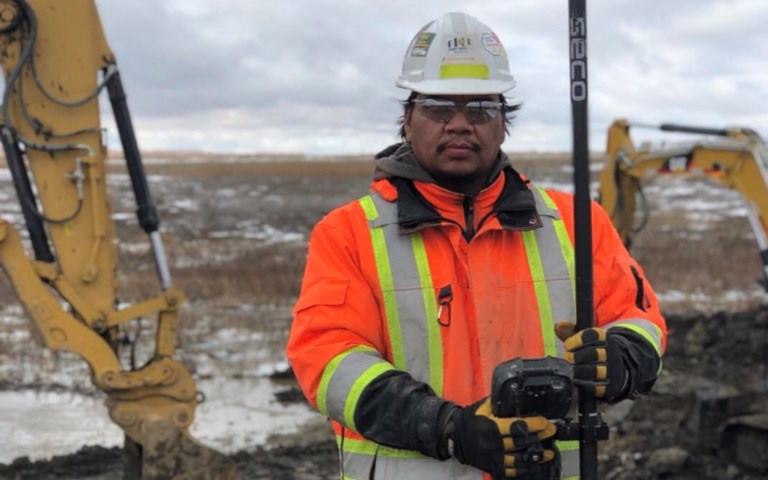Back in 2015, Steven Thomas was having trouble landing a job in the mining and construction industry. He was desperate to break into the field, but his job applications were going unanswered due to a lack of experience. At 34, he turned to his local Band office at the Pasqua First Nation Reserve in Saskatchewan, who pointed him towards Mining Essentials – a readiness training program for Indigenous People put on by the Mining Industry Human Resources Council (MiHR). The day after the program ended, Thomas was employed by his own community, Pasqua First Nation, as an environmental monitor.
Mining Essentials was established in 2012 in response to a needs analysis conducted by MiHR that showed that employers found that many Indigenous applicants lacked the skills required to enter the mining industry. That skills gap was a pressing concern given that employment quotas are a common feature of impact benefits agreements between mining companies and Indigenous communities. The needs analysis “came back strongly that essential skills and work readiness training would be beneficial to communities to get them into the industry,” said Pascale Larouche, senior manager of Indigenous affairs with MiHR.
There were employers with the intent to hire from nearby Indigenous communities, Larouche said, and there were youth with local knowledge but no industry experience looking for jobs. Creating the Mining Essentials program – a collaboration between MiHR, the Assembly of First Nations, employers, educators and other Indigenous organizations – was a solution that helped bridge that gap. There have been deliveries of the program in Ontario, Quebec, Saskatchewan, British Columbia and Nunavut, and Larouche aims to eventually have a program in every province and territory. Since launching, Mining Essentials has seen 683 enrolments, had 383 graduates; 77 are currently employed in the industry, while 54 have gone on to further their education.
Over the course of 12 weeks, learners in the program gain both theoretical classroom knowledge and hands-on experience at mine sites in order to prepare them for a career in mining. This is taught in conjunction with Indigenous practices and mediums; for example, an elder is part of every intake of the program.
For Thomas, the idea of working at a northern diamond mine while being able to travel, as well as earning a good income to support his daughter, excited him. “When I heard about getting the necessary training to work on mine sites, I was like, ‘Yes, that is exactly what I need to get the job that I’m after.’”
Thomas would have been “lost” without the training, he said. Learning different industry terms – like what a “berm” is (a raised barrier usually made of dirt) – and having a deeper understanding of safety and equipment was paramount to helping him to break into the industry. “When I actually got onto site and they were saying these words, it was like, ‘Okay, I know exactly what they’re talking about,’” he explained.
His first job out of the program as an environmental monitor in his community involved overseeing Kelly Panteluk Construction Ltd. (KPCL) on earth moving in the Qu’Apelle Valley, Saskatchewan. “It’s a pretty sensitive area in terms of the environment, and culturally speaking,” he said. While working as an environmental monitor, Thomas was struck by the care that KPCL took in protecting an Indigenous artifact that was uncovered in a dig. KPCL was equally taken with Thomas’s work ethic, and the week after his contract with Pasqua First Nation ended, Thomas was employed with the construction company. He works there today, and he’s climbing the ladder to foreman.
Since finishing the Mining Essentials program, Thomas has also worked as an environmental monitor with the Enbridge pipeline, mainly in archaeology, where he felt it was important to bring an Indigenous, cultural point of view, he said. “I was trying to bridge the gap between First Nations viewpoints on nature and industry [perspectives],” he explained. “Get them to see eye-to-eye and, kind of, show [each side] that they are actually after the same things.”
Related: Mentorship programs have their benefits but shouldn’t be the only solution to mining’s diversity problem.
There can be a perceived disconnect between the mining industry and Indigenous communities, especially when it comes to environmental impact. That’s something that Thomas went into the program thinking about critically. He admits that all he knew about mining were images from social media. Gaining a deeper understanding of the environmental practices of mining companies played an important part in his support of the industry. That’s something that Mining Essentials program manager and coordinator Gordon Kakegamic understands.
When working with communities in recruitment workshops, Kakegamic explains that mining needs to be a passion. “Talk to your community, talk to your family, check your heart,” Kakegamic said. “Do you support mining?” Those are the same questions Kakegamic asked himself in 2008, when he was approached by the then-Chief of the Matachewan First Nation to help prepare the community for the opening of the Young-Davidson gold mine. He came to the spiritual conclusion for himself that minerals were in the earth for a purpose, and that included economic growth and development.
The first Mining Essentials delivery that was entirely on-site happened under Kakegamic’s watch at the Goldcorp Musselwhite mine, a fly-in-fly-out operation in remote northern Ontario that has an Impact Benefits Agreement with the local Indigenous communities. The mine seeks to employ 30 per cent of its workforce from the signatory and affiliate communities as of 2017, according to Natural Resources Canada. At that time, 11 per cent of the Indigenous workforce came from the signatory communities, while eight per cent were Indigenous employees from other communities.
At Musselwhite, the learners mimicked a regular work schedule at the mine, which is two weeks in, two weeks out. “Basically, 50 per cent of the time you’re going to be away from your family, going to be away from your community,” Kakegamic said of the training. There was also a mobile classroom that allowed the students to learn at the mine site. “Most traditional training providers, when you step out of the classroom, you step into the hallway of their school,” he explained. “Our students, when they step out of the mobile lab classroom, they step out directly into the work site.” The work experience also means that supervisors at the mine can see a learner’s work ethic and recommend them for employment.
“I really think the mining industry needs to support our youth,” said Kakegamic. Going forward, he wants to see programs such as Mining Essentials continue to reach more Indigenous communities across the region.
For Thomas, a job in the industry means being able to help others. He often thinks about where a mined product goes and how it helps people that he’ll never meet. “[It’s] looking at the big picture and seeing our spiritual aspect of what I’m doing and how I’m helping people,” said Thomas. And, of course, the work gives him the opportunities to help his daughter attain her dreams. She’s currently planning on going to law school. “I think [that by] working in construction – and hopefully maybe one day going to those diamond mines – that I really help her [get her] law degree,” said Thomas. “Anything she wants to do.”
This article is part of our Future Prospects series, brought to you by Stantec. Running throughout 2019, this series will feature articles on how the mining workplace is changing and the strategies young professionals will need to build themselves a career in the digital mining industry.




